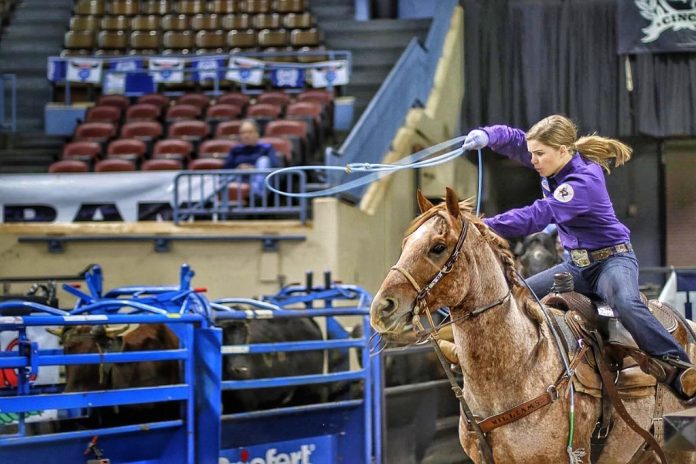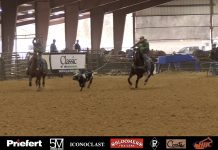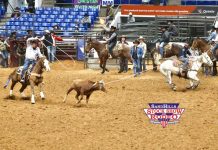Breaking it Down by Speed Williams – November 2024
When working with clients, or my kids, a main topic of discussion is about understanding your weaknesses. We film our runs and then go inside and watch the video. For me, a run is like a math equation. When you come across the line are your feet, legs, body, and arm all in correct position? And are you riding correctly? Is that move necessary for you to achieve your job?
For instance, when speaking about higher numbered headers who are trying to make the NFR, try to understand the math on how you start your rope and swing, and eliminate wasted motion. To be able to throw your rope, it must be balanced with some momentum to send it very far. There are a few people who swing slow but create momentum from their elbow to their wrist and force it with a flick. There are many different styles and ways guys have figured out how to throw fast.
One thing I’ve been working with Gabe on is to stay square in the saddle and use his legs to create the angles to pull the steer correctly. I put him on the Speed Trainer and set the dummy out about 20 feet. I want him to stay square in the saddle and use his left leg without putting pressure on his right leg that will make his horse duck.
Recently I flew to Utah for a few days for lessons with a 6+ and 7+ header. Both had a lot of ability with a rope. But when we watched the video, they leaned to the right and put their right leg in their horse with their left leg open. This means when they threw their rope, their horses ducked hard. It was amazing how much better their horses did once they started riding correctly.
As team ropers we don’t realize how many mistakes we make with our legs and left hand when we’re trying to rope a steer. Team ropers as a whole use their body to throw their rope and they give their horses lots of cues. It’s amazing how the special horses learn what they’re supposed to do and not do, regardless of the rider. I’ve had several clients who have bought nice, broke horses that are sensitive to their legs. When they come across the line, rope, and pull their slack, their left hand will extend all the way to the left. The horse will never break stride or try and go out. Then once they ride forward and dally and ask him to go left, the horse moves out. The horse has learned that the first move means nothing, but the second move means go left.
This is very common for heel horses on the stop. I’ve seen clients that when they come around the corner, they tend to lean and spur their horse in the belly. Their left hand is forward and when the rope comes out of their hand, the horse drags his butt. Even though they’re spurring him in the side, the horse doesn’t want to get his front feet in the rope. So, they learn to stop when the person changes the angle, speed, or when they lean forward. Horses are much more intelligent than people realize. Most ropers don’ t understand how many wrong cues we give our horse during a run.
It comes back to the reason I designed the Speed Trainer. It was to teach my kids and clients how to control their horse with their left hand and their legs. I teach a lot of timed drills on the ground with headers as far as swinging and moving their feet. Once we get to where we can do that, we get on the Speed Trainer. Learning to use your leg to control the horse and not just to hang on makes a tremendous difference. It keeps you from having to change bridles because you’re pulling and squeezing at the same time while you’re trying to make the run.
When someone asks me how they can get better, my usual answer is to learn to control your horse with less motion. Your hands and feet make smaller moves and control your horse with very little movement. There are many ways to head, heel, and rope calves. But when you can eliminate wasted motions in your swing, riding, and the steps your horse takes, then you’re understanding how to speed up your run, at all levels.
I believe my son is starting to like heading and the challenges that go with it. Time will tell how long it will take him to be competitive. My goal was to have him ready to compete by this summer, but we still have a long way to go. He turns 18 this month so I’m sure he’ll go to some of the rodeos and enter.
My daughter has really struggled this year with her foot where she cracked the bone, injured her Achilles tendon, the brevis tenon, and her knee. She was able to qualify for the NFBR this year but finished a couple of spots away from where she wanted to be for the Kimes Ranch Million Dollar Breakaway. The top 10 are in automatically, but the other five spots will be filled by qualification. I’m excited to see how this roping turns out because they’re roping for $25,000 a night versus the NFBR where they’re roping for $5,000 per round.
The Lord works in mysterious ways. Hali and Redlight had a wreck in the arena when she came home to practice. A calf ducked in front of him and Redlight went end over end. Hali had whiplash and some pain in her ribs and shoulder. She said, “Dad the funny thing is it feels like it put the rest of my body back in line and my foot doesn’t hurt.” She’s been very sore for a couple of weeks, but after healing up, she’s been able to ride multiple horses, and it almost feels like she’s healthy again. It’s been a long year of her not being able to put weight in her stirrup which has created some bad habits. It’s very hard to throw fast if you cannot use your right leg.
The first of November, we are setting up camp at Dean Tuftin’s, DT Horses, in Scottsdale, AZ. Gabe, Hali, and I will be hanging out in Arizona all month. Hali will be practicing for the Kimes Ranch roping Gabe will be riding with Dean and helping me with lessons.




